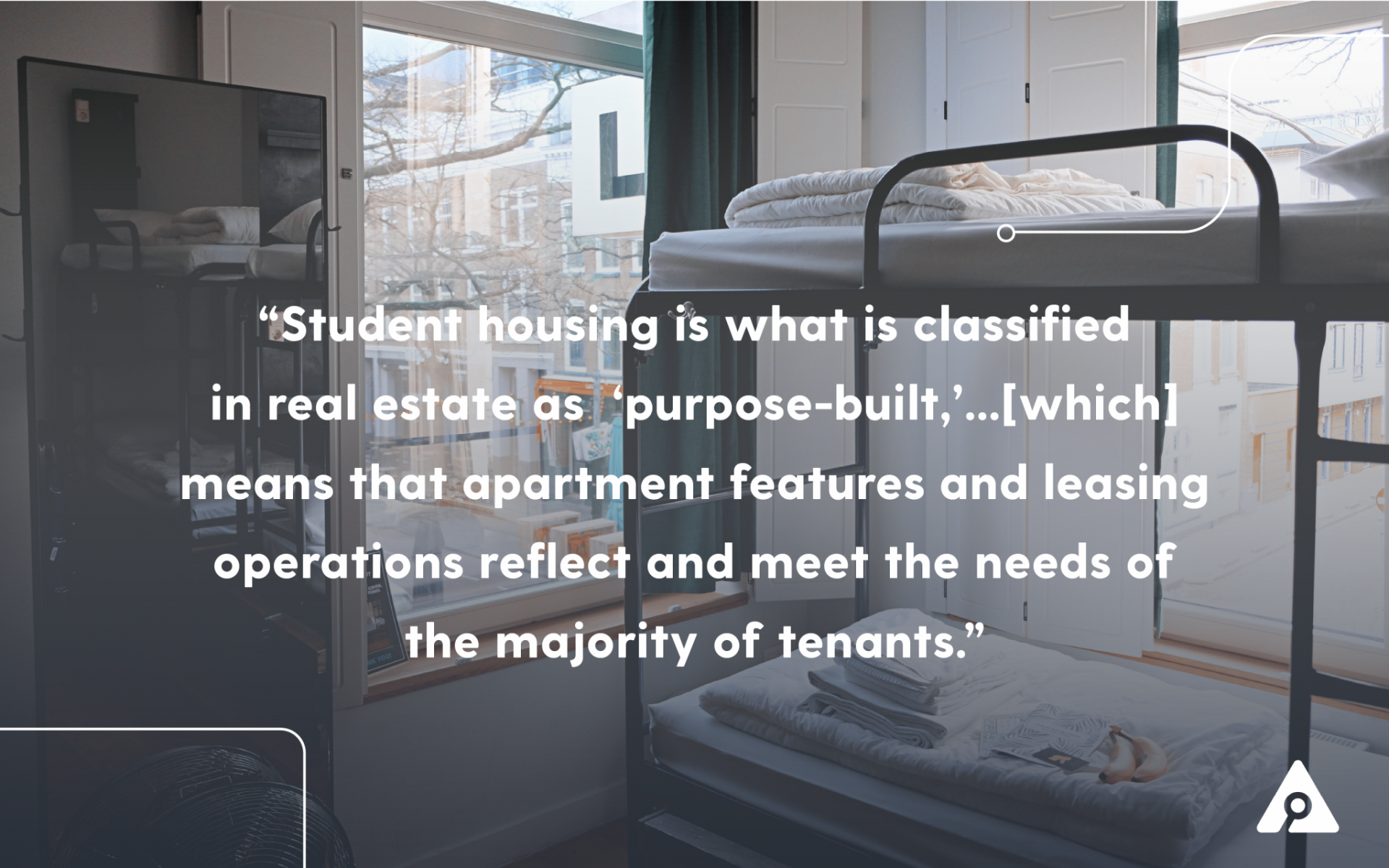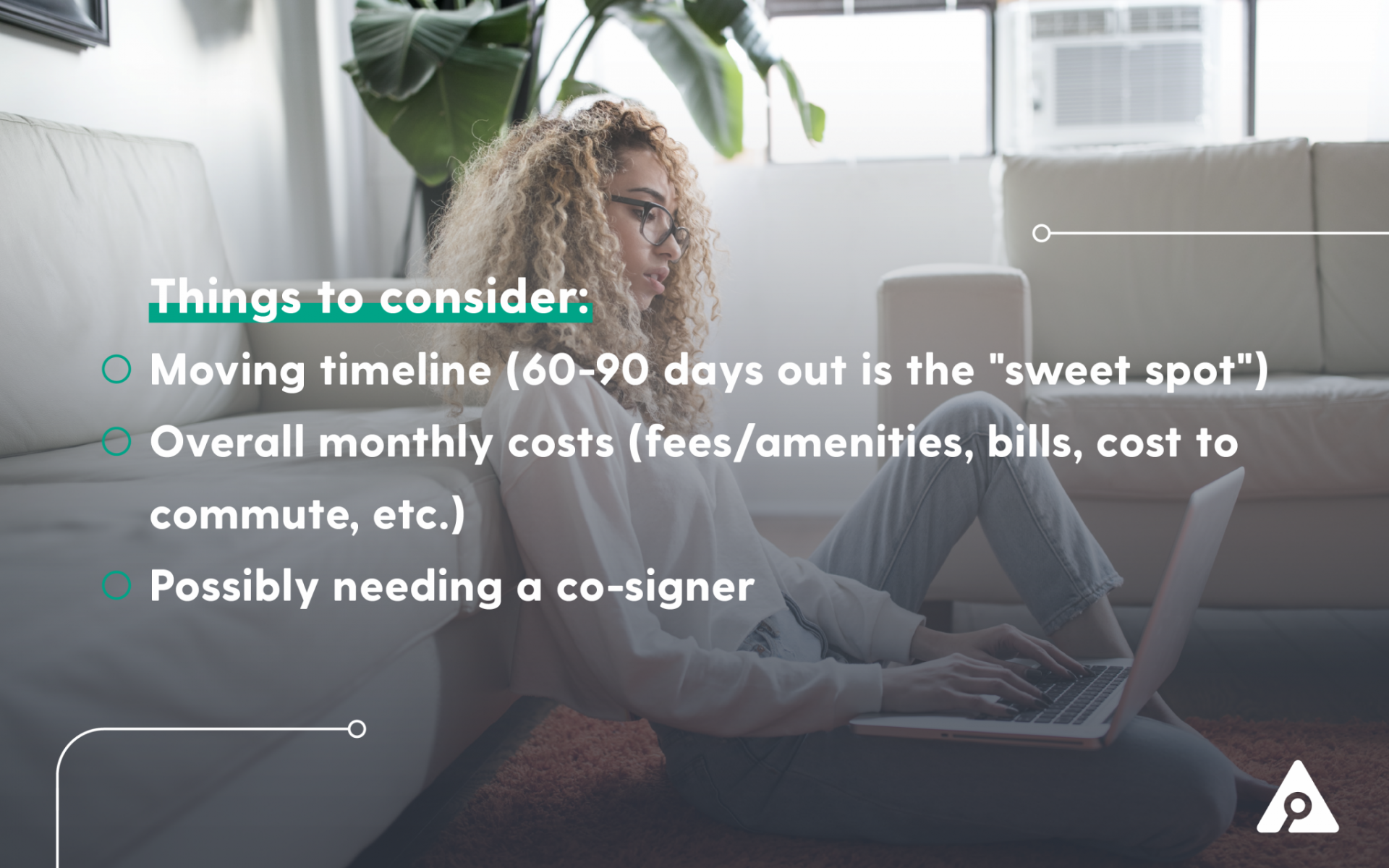Making the transition from student housing

If you’re a believer that renting an apartment will resemble the leasing framework and amount of responsibility experienced in student housing, we get it! While the two might seem to run synonymously, there are a few key differences that set student housing quite a ways apart from renting an apartment. If you’re looking to make the transition from student housing to an apartment separate from higher-education affiliations, we’re here to walk you through everything you need to know.
Get out your notebooks, renters; school’s in session.
What makes student housing, “student housing?”
One might think (read: every single one of us as students) that student housing is pretty self-explanatory, which it is. You’ve got a student, you’ve got housing of some sort; bada-bing bada-boom, you’ve got student housing. Student housing is what is classified in real estate as “purpose-built,” meaning it was built knowing from day one that it would house that subset of dweller/space consumer and only that, in this case, a variety of students. This also means that apartment features and leasing operations reflect and meet the needs of the majority of tenants. Examples of student housing include on and off-campus dormitories and off-campus apartment properties closely affiliated with local schools, and can typically be reserved a semester or two ahead of the desired move-in date.
Student housing boasts features such as short-term or by-bed lease agreements, reserving units months out from the start of an academic semester, roommate matching, furniture, meal plans connected to nearby institutions, bundled monthly bills, walkability, or close proximity to local schools; you get the picture! So, while processes, like applying and leveraging a guarantor, agreeing to background checks, and paying fees upfront, do mimic that of leasing an apartment, there are a few differences that are important to know prior to making the transition.
As a secondary note, if you chose to rent an apartment while being a student and your lease is up soon, make sure you know your options before deciding to renew!
Key differences between student housing and leasing an apartment
Apartment properties are considered multi-family developments in real estate, or a building housing separate residences for multiple leaseholders and/or family members to live in. You have a lot more “say” in what you want to get out of your apartment space. The property essentially becomes the skeleton to the type of living you desire, serving as the framework to build upon everything that’s important when it comes to your home. Do you want to live close to work, or family, or school? Is a roommate necessary in order to live in your preferred neighborhood? Will living in an energy-efficient space help lower monthly costs when it comes to bills? What property features and unit finishes are essential? The apartment market is your oyster.

Another key difference between leasing an apartment and student housing are monthly bills and property fees. Apartment properties will charge monthly fees for things like valet trash pick-up (placing your trash bin outside your door for disposal), pest control, amenity maintenance, gas, water, and pets (yes, monthly pet fees). If your student housing residence bundled bills such as utilities, cable, and wifi, those are also itemized expenses you’ll want to take into account prior to signing an apartment lease. Anticipating monthly bills and property fees will help you establish a comfortable base rent upon making your initial transition.
You’ll also notice that for the most part, apartments are BYOFn’R – bring your own furniture and roommate. Apartment leasing teams don’t typically help tenants find roommates or furniture. If you plan on living with a roommate or two, make sure you’ve chatted with them already and that you tour properties together if at all possible so you can talk through furniture needs and space logistics. You’ll also want to make sure you’re all on the same page when it comes to the lease agreement because apartment leases are not finalized on a by-room basis, so each roommate is equally responsible for any damages done, even if it’s in a room that’s not yours. If a temporary placement or the opportunity to become a fixed-term ex-pat presents itself, finding an apartment with furniture can be done, it just takes some extra time.
Preparing to transition from student housing to an apartment
We think we’ve made our point that transitioning from student housing to a normal apartment lease takes preparation and planning to make sure all the Ts are crossed and the Is are dotted because a lease agreement is a legally binding contract! Here are specific things to consider as you make the transition from student housing:
-Moving timeline – you’ll want to begin your search 60-90 days out from when your current lease is up, or from when you’re planning to move. Most properties don’t have a scope on availability more than 90 days out.
-Making time to tour the properties you’re interested in with the intent to complete an application that same day (which means you’ve probably already whittled down your list).
-The anticipated cost of monthly expenses such as utilities, cable/internet, parking, property fees, location in regards to communing, and gas consumption/spend.
-A comfortable base rent (meaning rent before other monthly expenses associated with your apartment)
-Furniture, appliance, and kitchen needs – What furniture do you need to acquire? What cooking supplied to you need vs the amount of storage you’ll have? Does your unit have a washer and dryer in-unit?
Leveraging a co-signer on your new apartment lease
In our recent blog about co-signers, we touched on everything from the definition to the process, to frequent misconceptions. Sometimes properties ask applicants to have a co-signer on their lease in order to increase their chances of getting the unit by reducing the “risk” the property is taking on a primarily new renter. Think of it as an added layer of contractual reassurance for the property that rent payments and damages will always be covered! Unless you’re under the age of 18, a co-signer does not have to be a parent or a guardian, just someone willing to take on the legal ramifications that can take place should the lease agreement be broken for any reason.
Yes, the previous sentence was written a little nonchalant, but choosing to leverage a co-signer for your lease should definitely be considered from all angles, especially if you’ll be renting with roommates. There is one majorly important note to make in regards to renting with a roomie and leveraging a co-signer, especially if the co-signer is someone you’re personally deciding to bring into the lease agreement. Even if it’s not YOU who acquire damages or cause a delay in rent payment, YOUR co-signer is still responsible for the monetary and legal outcome of that. Maybe it’s your parent who decides to be the co-signer on your lease but it’s your roommate’s dog who eats an entire room’s worth of carpet, acquiring fees greater than the pet deposit that they choose not to pay; your parent will be just as liable as you to fill that monetary gap.
To learn more about the importance and impact of leveraging a co-signer for your lease agreement, click here.

Using a free apartment locator
Shameless plug? Absolutely, but with a major value proposition. Using an apartment locator offers renters a personal liaison versed in the city’s apartment rental market and competitive rates. Most renters look for an apartment once a year, while we run apartment searches every single day. So, we know our stuff and we know how to properly set the expectations of our clients based on facts. Using a locator also offers a higher level of efficiency with apartment searches, saving the renter lots of time and money!
When you get connected with a Smart City agent, they’ll gather every detail around your budget and what’s important to you so they can accurately educate you on the market and set your expectations. They’ll then return a list of hand-picked properties that meet that criteria. By the time the list has graced your presence, your agent has already contacted all properties that *could* fit your unique criteria and whittled that down to the ones that offer the most value. They asked each property things like move-in specials they have going on, pricing according to various move-in dates to fish out the best rate, application fees, and details around pets. Then, they consult with other agents on the team just to cross-check that they didn’t miss a property or move-in special out there. Once clients begin touring, our agents gather feedback and help navigate the client through the application process to lock down that dream apartment!
You might be wondering “but why is all that free?” It’s simple, really. As an industry, apartment locators and brokers get compensated by apartment properties based on a commission rate reflective of the property’s marketing budget. Properties get access to our network of clients who need to be connected to their dream apartment, our clients get to see their absolute best options, and we get to keep the lights on – it’s a win/win/win! If you’re interested in getting connected with an agent, click here, select your desired city, and ‘Get Started!’
To keep tabs on the best apartment deals in your area, follow us on Instagram:







